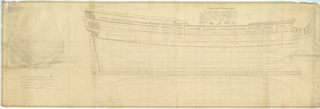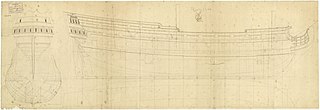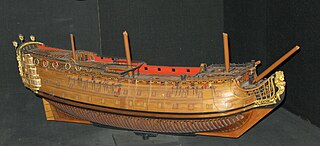
HMS Royal Oak was a 74-gun third-rate ship of the line of the Royal Navy, built by Jonas Shish at Deptford and launched in 1674. She was one of only three Royal Navy ships to be equipped with the Rupertinoe naval gun. Life aboard her when cruising in the Mediterranean Sea in 1679 is described in the diary of Henry Teonge.

HMS Northumberland was a 70-gun third rate ship of the line of the Royal Navy, built at Plymouth Dockyard to the draught specified by the 1745 Establishment, and launched on 1 December 1750.

HMS Augusta was a 64-gun third rate ship of the line of the Royal Navy, launched on 24 October 1763 at Rotherhithe.

HMS Venerable was a 74-gun third-rate ship of the line of the Royal Navy, launched on 19 April 1784 at Blackwall Yard.

Bienfaisant was a 64-gun ship of the line of the French Navy, launched in 1754.
HMS Greenwich was a 54-gun fourth-rate ship of the line of the Royal Navy, built by Christopher Pett at Woolwich Dockyard and launched in 1666.

HMS St Michael was a 90-gun second rate ship of the line of the Royal Navy, built by John Tippetts of Portsmouth Dockyard and launched in 1669.
HMS Defiance was a 64-gun third rate ship of the line of the Royal Navy, built by Phineas Pett II at Chatham Dockyard, and launched in 1675.

HMS Oxford was a 54-gun fourth-rate ship of the line of the Royal Navy, built by Francis Baylie in Bristol and launched in June 1674. Her guns comprised twenty-two 24-pounders on the lower deck, with twenty-two large sakers (8-pounders) on the upper deck and ten smaller sakers (5-pounders) on the quarter deck.

HMS Kingston was a 60-gun fourth-rate ship of the line of the Royal Navy, built by Frame in Hull and launched on 13 March 1697. She had an eventful career, taking part in numerous engagements.
HMS Triumph was a 90-gun second rate ship of the line of the Royal Navy, launched at Chatham Dockyard on 2 March 1697. She was renamed HMS Prince in 1714.
Blackwall was a 50-gun fourth-rate ship of the line of the English Royal Navy, launched at Blackwall Yard in 1696.

The 1706 Establishment was the first formal set of dimensions for ships of the Royal Navy. Two previous sets of dimensions had existed before, though these were only for specific shipbuilding programs running for only a given amount of time. In contrast, the 1706 Establishment was intended to be permanent.

HMS Lion or Lyon was a 60-gun fourth rate ship of the line of the Royal Navy, built at Chatham Dockyard to the 1706 Establishment and launched on 20 January 1709.
HMS Tilbury was a 60-gun fourth-rate ship of the line of the Royal Navy, built at Chatham Dockyard to the dimensions of the 1719 Establishment, and launched on 2 June 1733.

HMS Pembroke was a 60-gun fourth rate ship of the line of the Royal Navy, built to the dimensions of the 1719 Establishment at Woolwich Dockyard, and launched on 27 November 1733.
HMS Tilbury was a 58-gun fourth rate ship of the line of the Royal Navy, ordered from Portsmouth Dockyard on 17 December 1742 and built by Peirson Lock to the dimensions laid down in the 1741 proposals of the 1719 Establishment. She was launched on 20 July 1745.

HMS Ruby was a 50-gun fourth rate ship of the line of the Royal Navy, built at Bursledon in Hampshire to the dimensions specified in the 1741 proposals of the 1719 Establishment, and launched on 3 August 1745.

HMS Colchester was a 50-gun fourth rate ship of the line of the Royal Navy, built at Southampton according to the dimensions laid down in the 1741 proposals of the 1719 Establishment, and launched on 20 September 1745. She was ordered as a replacement for the previous HMS Colchester, which had been wrecked just two months after being launched.

HMS Dunkirk was a 60-gun fourth-rate ship of the line of the Royal Navy, built by Edward Allin at Woolwich Dockyard to the draught specified by the 1745 Establishment as amended in 1750, and launched on 22 July 1754.












